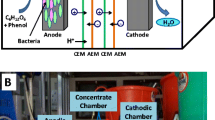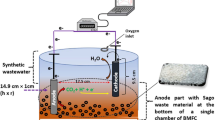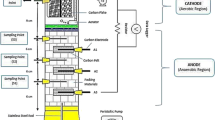Abstract
The cooperative relationships of natural environmental microbial consortia and synthetic microbial consortia have inspired for studying microbial interactions and various engineering applications. In this current study, different industrial wastewaters (distillery spent wash (DSW), pharmaceutical and dairy wastewater) were treated in three different microbial fuel cells (MFCs) with single and mixed culture bacteria. The performance of MFCs was evaluated considering the major parameters like organic matter removal, voltage generation and biomass production using mixed and single cultures. The maximum COD removal efficiency of 72.5 ± 0.5% from DSW, 85 ± 0.5% from pharmaceutical wastewater and 86 ± 0.5% from dairy wastewater were observed. The results indicate the effective symbiotic relation of Pseudomonas aeruginosa and Bacillus cereus for bioremediation in MFC. The maximum voltage generation of 350.2 ± 0.5 mV in MFC using DSW, 705.4 ± 0.5 mV in MFC using pharmaceutical wastewater and 787.47 ± 0.5 mV in MFC using dairy wastewater were observed relatively higher than other previous study using mixed culture. The produced CO2 from the biogas of anode chamber was transferred from anodic chamber to cathodic chamber for effective utilization in microalgal growth. The maximum algal biomass of 0.52 ± 0.05 g/L from MFC1B+P, 0.82 ± 0.05 g/L from MFC2B+P and 0.95 ± 0.05 g/L from MFC3B+P was observed. First order of kinetic model was performed, and as a result, the model was found appropriate and validate the experimental results. This study reveals the possibility of using adapted microbial consortia in MFCs for achieving efficient bioremediation of organic and inorganic contaminates and concomitant bioelectricity generation using different industrial wastewater.







Similar content being viewed by others
References
Islam A, Hwa Teo S, Awual MR, Taufiq-Yap YH (2020) Ultrathin assembles of porous array for enhanced H2 evolution. Sci Rep 10(1):1–14
Islam A, Teo SH, Awual MR, Taufiq-Yap YH (2020) Assessment of clean H2 energy production from water using novel silicon photocatalyst. J Clean Prod 244:1–12
Ahmed J, Thakur A, Goyal A (2021) Chapter 1: Industrial wastewater and its toxic effects. 1–14. https://doi.org/10.1039/9781839165399-00001
Teo SH, Islam A, Taufiq-Yap YH, Awual MR (2021) Introducing the novel composite photocatalysts to boost the performance of hydrogen (H2) production. J Clean Prod 313:127909. https://doi.org/10.1016/j.jclepro.2021.127909
Zhang T, Wang X, Zhang X (2014) Recent progress in TiO2-mediated solar photocatalysis for industrial wastewater treatment. Int J Photoenergy 2014. https://doi.org/10.1155/2014/607954
Amit, Kumar, N., Verma, S., Park, J., Jaiswal, A. K., Ghosh, U. K., and Gautam, R. (2022) Utilization of nano-sized waste lime sludge particles in harvesting marine microalgae for biodiesel feedstock production. Nanotechnology for Environmental Engineering 2021 7:1, 7(1), 99–107. [online] https://link.springer.com/article/10.1007/s41204-021-00195-0 (Accessed April 2, 2022)
Gautam R Nayak J K Daverey A and Ghosh U K (2022) Emerging sustainable opportunities for waste to bioenergy: an overview. Waste-to-Energy Approaches Towards Zero Waste, 1–55
Yeamin M. Bin, Islam MM, Chowdhury AN, Awual MR (2021) Efficient encapsulation of toxic dyes from wastewater using several biodegradable natural polymers and their composites. J Clean Prod 291:125920. https://doi.org/10.1016/j.jclepro.2021.125920
Ahammad, S. Z. and Sreekrishnan T. R. (2016) Energy from wastewater treatment. Bioremediation and Bioeconomy 523–536
Awual MR (2015) A novel facial composite adsorbent for enhanced copper(II) detection and removal from wastewater. Chem Eng J 266:368–375. https://doi.org/10.1016/j.cej.2014.12.094.
Hasan MN, Shenashen MA, Hasan MM, Znad H, Awual MR (2021) Assessing of cesium removal from wastewater using functionalized wood cellulosic adsorbent. Chemosphere 270:128668
Khandaker S, Bashar MM, Islam A, Hossain MT, Teo SH, Awual MR (2022) Sustainable energy generation from textile biowaste and its challenges: a comprehensive review. Renew Sust Energ Rev 157(January):112051. https://doi.org/10.1016/j.rser.2021.112051
Znad H, Al-Mohammedawi H, Awual MR (2021) (2021) Integrated pre-treatment stage of biosorbent – sonication for mixed brewery and restaurant effluents to enhance the photo-fermentative hydrogen production. Biomass and Bioenergy 144(November 2020):10589. https://doi.org/10.1016/j.biombioe.2020.105899
Belov V, Komandresova T, Samarkin A (2017) IOP Conference Series: earth and environmental science a review on advanced treatment of pharmaceutical wastewater. IOP Conf. Ser Earth Environ. Sci 63:12025
Das MP, Bashwant M, Kumar K, Das J (2012) Control of pharmaceutical effluent parameters through bioremediation. J Chem Pharm Res 4(2):1061–1065
Madukasi EI, Dai X, He C, Zhou J (2010) Potentials of phototrophic bacteria in treating pharmaceutical wastewater. Int J Environ Sci Technol 7(1):165–174
Pilli S. Sellamuthu B. Pandey A. K. and Tyagi R. D. (2020) Treatment of wastewater containing pharmaceuticals: biological treatment. Current Developments in Biotechnology and Bioengineering, 463–520
Kumar V. and Chandra, R. (2020) Metagenomics analysis of rhizospheric bacterial communities of Saccharum arundinaceum growing on organometallic sludge of sugarcane molasses-based distillery. 3 Biotech 10(7) 1–18. [online] https://doi.org/10.1007/s13205-020-02310-5
Saner AB, Mungray AK, Mistry NJ (2016) Treatment of distillery wastewater in an upflow anaerobic sludge blanket (UASB) reactor. Desalination Water Treat 57(10):4328–4344. https://doi.org/10.1080/19443994.2014.994107
Vijayaraghavan K, Ramanujam TK (2000) Performance of anaerobic contact filter in series for treating distillery spentwash. Bioprocess Eng 22(2):109–114
Ahmad T Aadil, R. M Ahmed H., Rahman U. ur, Soares, B. C. V., Souza, S. L. Q., Pimentel, T. C., Scudino, H., Guimarães, J. T., Esmerino, E. A., Freitas, M. Q., Almada, R. B., Vendramel, S. M. R., Silva, M. C., and Cruz, A. G. (2019) Treatment and utilization of dairy industrial waste: a review. Trends in Food Science and Technology 88(December 2018):361–372. https://doi.org/10.1016/j.tifs.2019.04.003
Sinha N. and Dahiya P. (2022) Removal of emerging contaminants from pharmaceutical wastewater through application of bionanotechnology. Development in Wastewater Treatment Research and Processes 247–264
Patel H. K. Kalaria R. K. Jokhakar P. H. Patel C. R. and Patel B. Y. (2022) Removal of emerging contaminants in water treatment by an application of nanofiltration and reverse osmosis. Development in Wastewater Treatment Research and Processes, 385–400
Kull K (2010) Ecosystems are made of semiosic bonds: consortia, umwelten, biophony and ecological codes. Biosemiotics 3(3):347–357
Hayat K, Menhas S, Bundschuh J, Chaudhary HJ (2017) Microbial biotechnology as an emerging industrial wastewater treatment process for arsenic mitigationA critical review. J Clean Prod 151:427–438. https://doi.org/10.1016/j.jclepro.2017.03.084
Tan X, Acquah I, Liu H, Li W, Tan S (2019) A critical review on saline wastewater treatment by membrane bioreactor (MBR) from a microbial perspective. Chemosphere 220:1150–1162. https://doi.org/10.1016/j.chemosphere.2019.01.027
Nayak JK, Amit, Ghosh UK (2018) An innovative mixotrophic approach of distillery spent wash with sewage wastewater for biodegradation and bioelectricity generation using microbial fuel cell. J Water Process Eng 23:306–313
Khandaker S, Das S, Hossain MT, Islam A, Miah MR, Awual MR (2021) Sustainable approach for wastewater treatment using microbial fuel cells and green energy generation—a comprehensive review. Journal of Molecular Liquids 344:117795. https://doi.org/10.1016/j.molliq.2021.117795
Gautam R Nayak J K Talapatra K. N Amit and Ghosh U. K. (2021) Assessment of different organic substrates for bio-electricity and bio-hydrogen generation in an integrated bio-electrochemical system. Materials Today: Proceedings, (xxxx), 6–10
Jahnke J P Sarkes D.A Liba, J L Sumner J. J and Stratis-Cullum, D. N. (2021) Improved microbial fuel cell performance by engineering E. coli for enhanced affinity to gold. Energies 14(17)
Rojas-Flores S, Pérez-Delgado O, Nazario-Naveda R, Rojales-Alfaro H, Benites SM, De La Cruz-Noriega M, Otiniano NM (2021) Potential use of papaya waste as a fuel for bioelectricity generation. Processes 9(10):1–11
García-Mayagoitia, S., Fernández-Luqueño, F., Morales-Acosta, D., Carrillo-Rodríguez, J. C., García-Lobato, M. A., De La Torre-Saenz, L., Alonso-Lemus, I. L., and Rodrĺguez-Varela, F. J. (2019) Energy generation from pharmaceutical residual water in microbial fuel cells using ordered mesoporous carbon and Bacillus subtilis as bioanode. ACS Sustainable Chemistry and Engineering, 7(14), 12179–12187. [online] https://pubs.acs.org/doi/abs/10.1021/acssuschemeng.9b01281 (Accessed April 1, 2022)
Qiao YJ, Qiao Y, Zou L, Wu XS, Liu JH (2017) Biofilm promoted current generation of Pseudomonas aeruginosa microbial fuel cell via improving the interfacial redox reaction of phenazines. Bioelectrochemistry 117:34–39
Akhbari A, Zinatizadeh AAL, Mohammadi P, Mansouri Y, Irandoust M, Isa MH (2012) Kinetic modeling of carbon and nutrients removal in an integrated rotating biological contactor-activated sludge system. Int J Environ Sci Technol 9(2):371–378
Weng C, Molof AH (1974) Nitrification in the biological fixed-film rotating disk system 46(7):1674–1685
Kumar V, Wati L, FitzGibbon F, Nigam P, Banat IM, Singh D, Marchant R (1997) Bioremediation and decolorization of anaerobically digested distillery spent wash. Biotech Lett 19(4):311–314
Werner CM, Hoppe-Jones C, Saikaly PE, Logan BE, Amy GL (2015) Attenuation of trace organic compounds (TOrCs) inbioelectrochemical systems. Water Res 73:56–67. https://doi.org/10.1016/j.watres.2015.01.013
Jiang B, Li A, Cui D, Cai R, Ma F, Wang Y (2014) Biodegradation and metabolic pathway of sulfamethoxazole by Pseudomonas psychrophila HA-4, a newly isolated cold-adapted sulfamethoxazole-degrading bacterium. Appl Microbiol Biotechnol 98(10):4671–4681
Elakkiya E, Matheswaran M (2013) Comparison of anodic metabolisms in bioelectricity production during treatment of dairy wastewater in Microbial Fuel Cell. Bioresour Technol 136:407–412. https://doi.org/10.1016/j.biortech.2013.02.113
Sanjay S, Udayashankara TH (2020) Dairy wastewater treatment with bio-electricity generation using dual chambered membrane-less microbial fuel cell. Mater Today Proceedings 35, Part 3, (2021) 308–311. https://doi.org/10.1016/j.matpr.2020.01.533
Amit, Nayak JK, Ghosh UK (2020) Microalgal remediation of anaerobic pretreated pharmaceutical wastewater for sustainable biodiesel production and electricity generation. J Water Process Eng 35(2020):101192. https://doi.org/10.1016/j.jwpe.2020.101192
Singh R, Gautam N, Mishra A, Gupta R (2011) Heavy metals and living systems: an overview. Indian Journal of Pharmacology 43(3):246–253
Kaewchai S, Prasertsan P (2002) Biosorption of heavy metal by thermotolerant polymer-producing bacterial cells and the bioflocculant. J Sci Technol 24(3):421–430
Mehrarad F, Ziarati P, Mousavi Z (2016) Removing heavy metals from pharmaceutical effluent by pelargonium grandiflorum. Biomedical and Pharmacology Journal 9(1):151–161
Maness PC, Huang J, Smolinski S, Tek V, Vanzin G (2005) Energy generation from the CO oxidation-hydrogen production pathway in Rubrivivax gelatinosus. Appl Environ Microbiol 71(6):2870–2874
Chaudhuri SK, Lovley DR (2003) Electricity generation by direct oxidation of glucose in mediatorless microbial fuel cells. Nat Biotechnol 21(10):1229–1232
Nayak JK, Ghosh UK (2019) Post treatment of microalgae treated pharmaceutical wastewater in photosynthetic microbial fuel cell (PMFC) and biodiesel production. Biomass and Bioenergy 131(2019):105415. https://doi.org/10.1016/j.biombioe.2019.105415
Zhang J, Zheng P, Zhang M, Chen H, Chen T, Xie Z, Cai J, Abbas G (2013) Kinetics of substrate degradation and electricity generation in anodic denitrification microbial fuel cell (AD-MFC). Biores Technol 149:44–50
Velvizhi G, Venkata Mohan S (2012) Electrogenic activity and electron losses under increasing organic load of recalcitrant pharmaceutical wastewater. Int J Hydrog Energy 37(7):5969–5978. https://doi.org/10.1016/j.ijhydene.2011.12.112
Mohanakrishna G, Venkata Mohan S, Sarma PN (2010) Bio-electrochemical treatment of distillery wastewater in microbial fuel cell facilitating decolorization and desalination along with power generation. Journal of Hazardous Materials 177(1–3):487–494. https://doi.org/10.1016/j.jhazmat.2009.12.059
Choudhury P, Ray RN, Bandyopadhyay TK, Bhunia B (2020) Fed batch approach for stable generation of power from dairy wastewater using microbial fuel cell and its kinetic study. Fuel 266(2020):117073. https://doi.org/10.1016/j.fuel.2020.117073
Mazzucotelli C. A. Agüero M. V. del Rosario Moreira M., and Ansorena, M. R. (2016) Optimization of medium components and physicochemical parameters to simultaneously enhance microbial growth and production of lypolitic enzymes by Stenotrophomonas sp. Biotechnology and Applied Biochemistry, 63(3), 407–418. [online] http://doi.wiley.com/10.1002/bab.1378 (Accessed July 29, 2020)
Venkata Mohan S, Mohanakrishna G, Srikanth S, Sarma PN (2008) Harnessing of bioelectricity in microbial fuel cell (MFC) employing aerated cathode through anaerobic treatment of chemical wastewater using selectively enriched hydrogen producing mixed consortia. Fuel 87(12):2667–2676
Borja A, Elliott M, Andersen JH, Cardoso AC, Carstensen J, Ferreira JG, Heiskanen AS, Marques JC, Neto JM, Teixeira H, Uusitalo L, Uyarra MC, Zampoukas N (2013) Good environmental status of marine ecosystems: what is it and how do we know when we have attained it? Mar Pollut Bull 76(1–2):16–27
Jiménez AM, Borja R, Martín A, Raposo F (2006) Kinetic analysis of the anaerobic digestion of untreated vinasses and vinasses previously treated with Penicillium decumbens. J Environ Manage 80(4):303–310
Monod J. (1949) A certain number. Annual Reviews in M, 3(Xl) 371–394
à D T S (2008) Kinetic of carbonaceous substrate in an upflow anaerobic sludge sludge blanket (UASB) reactor treating 2 4 dichlorophenol (2 4 DCP). 86, 121–131
Prakash N. Sockan V. and Raju V. (2011) Anaerobic digestion of distillery spent wash. ARPN Journal of Science and Technology, 4(3) 134–140. [online] http://www.ejournalofscience.org/archive/vol4no3/vol4no3_3.pdf
Liwarska-Bizukojc, E., Galamon, M., and Bernat, P. (2018) Kinetics of biological removal of the selected micropollutants and their effect on activated sludge biomass. Water, Air, and Soil Pollution 229(11)
Funding
The study was financially supported by the Ministry of Human Resources and Development (MHRD), Government of India.
Author information
Authors and Affiliations
Contributions
Jagdeep Kumar Nayak: investigation, analysis and writing initial draft; Rahul Gautam: Editing, analysis and proof reading; Uttam Ghosh: conceptualization, funding, project administration and final draft.
Corresponding author
Ethics declarations
Conflict of interest
The authors declare no competing interests.
Additional information
Publisher's note
Springer Nature remains neutral with regard to jurisdictional claims in published maps and institutional affiliations.
Rights and permissions
About this article
Cite this article
Nayak, J.K., Gautam, R. & Ghosh, U.K. Bioremediation potential of bacterial consortium on different wastewaters for electricity and biomass feedstock generation. Biomass Conv. Bioref. 14, 11295–11308 (2024). https://doi.org/10.1007/s13399-022-02992-2
Received:
Revised:
Accepted:
Published:
Issue Date:
DOI: https://doi.org/10.1007/s13399-022-02992-2




